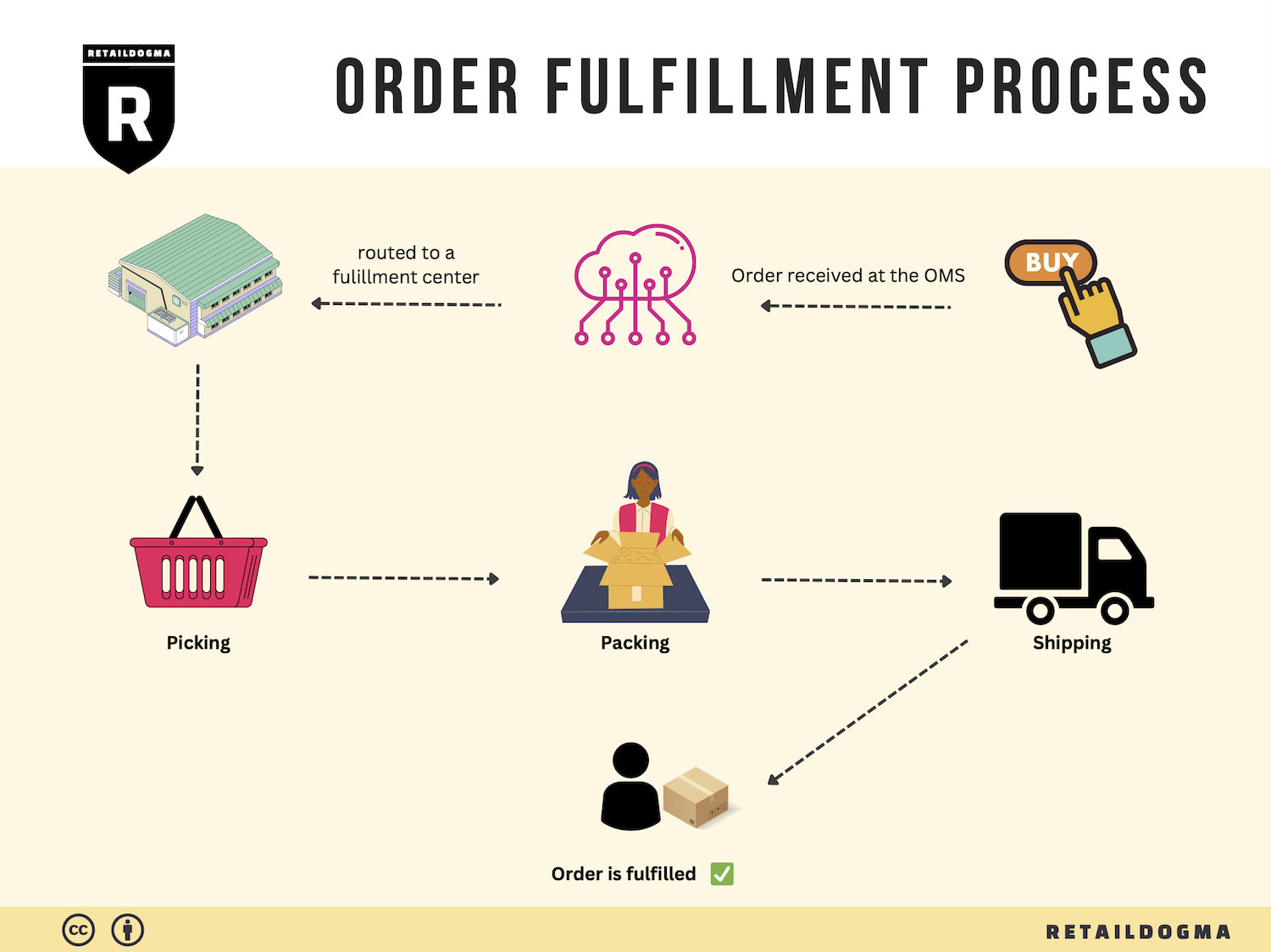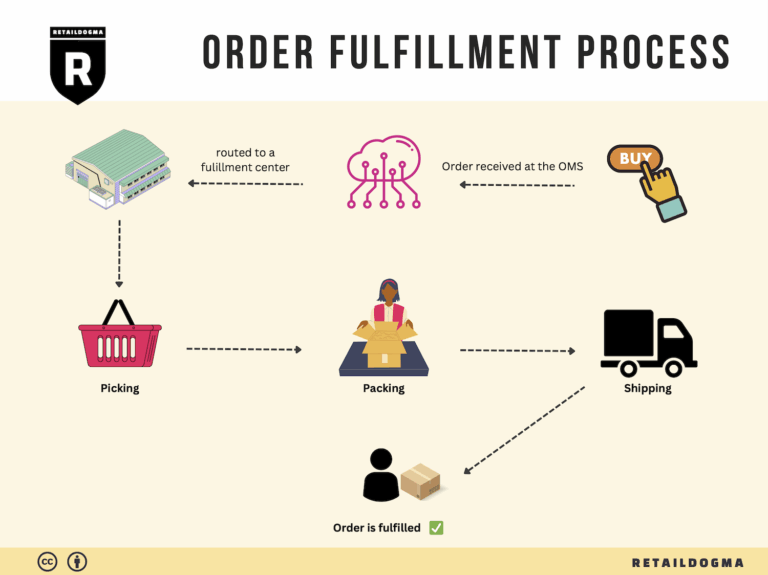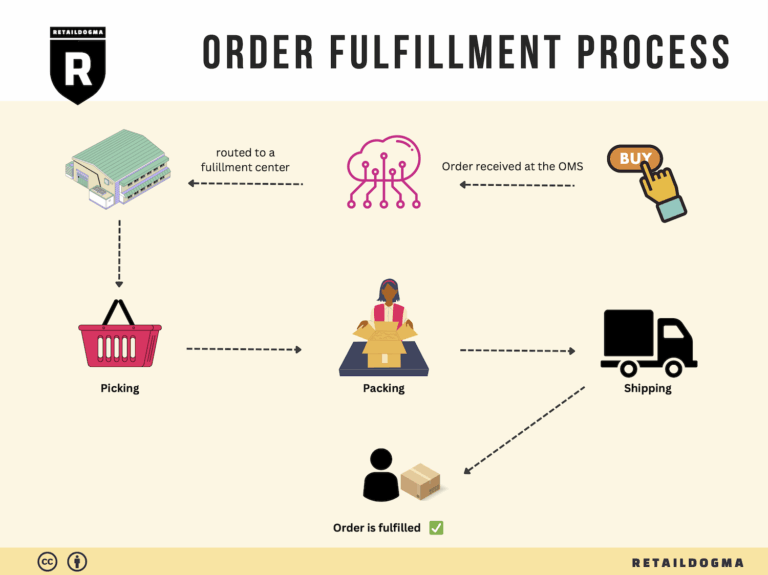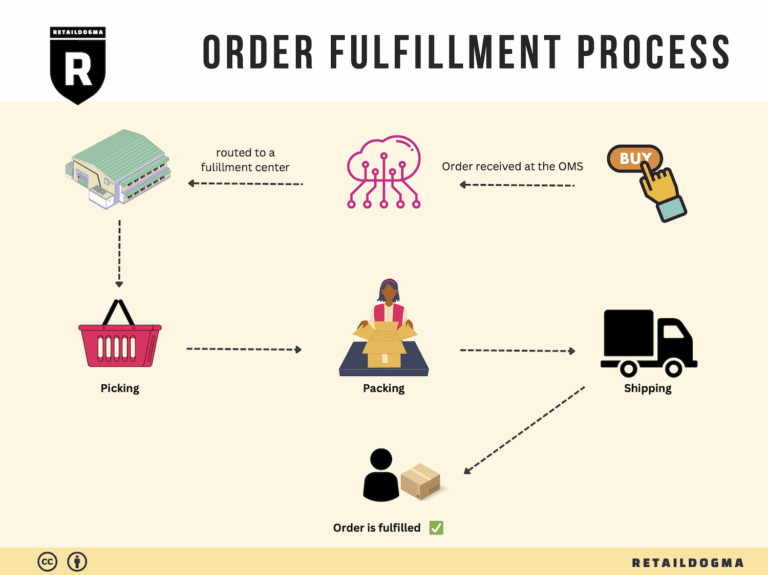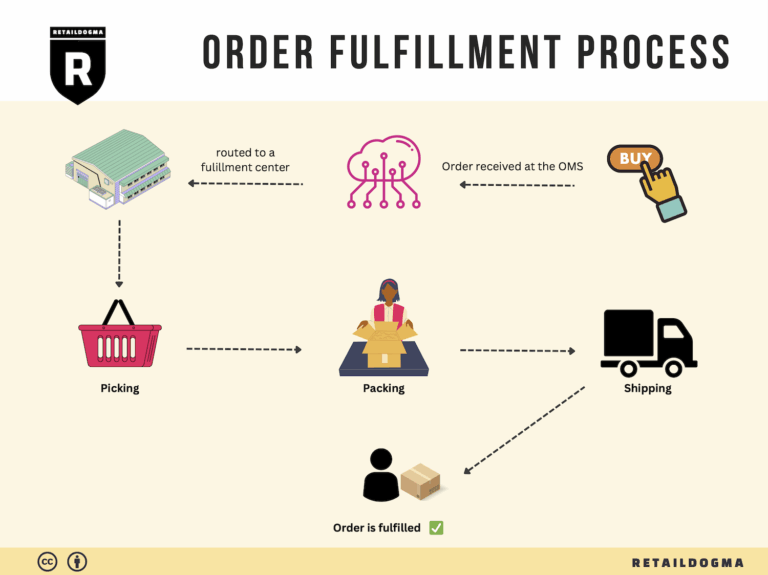Ecommerce Fulfillment Services: The Ultimate Guide (2025)
What is E-commerce Fulfillment? An Introduction for Growing Businesses
Understanding E-commerce Fulfillment
As an e-commerce business owner or operations manager, you likely find yourself grappling with the challenge of efficiently packing and shipping orders. The excitement of growing sales can quickly turn into chaos when the logistical demands start to overwhelm your resources. This is where e-commerce fulfillment steps in—a crucial process that involves getting your products from your inventory to your customers’ doorsteps.
Fulfillment is more than just shipping; it’s the entire journey of an order, starting from the moment a customer clicks “buy” to the time they receive their package. For growing businesses, mastering this process is vital not only for customer satisfaction but also for maintaining operational efficiency. With the right fulfillment strategy, you can transform a potentially overwhelming task into a streamlined operation, allowing you to focus on what you do best: growing your business.
In this guide, we will explore various fulfillment models, including third-party logistics (3PL) and Fulfilled by Amazon (FBA), among others. Each model has its strengths and weaknesses, making it essential to understand how they align with your business needs. We’ll break down the core services involved in fulfillment—such as inventory management, order processing, and shipping—so you can determine what fits your operational requirements.
Choosing the right fulfillment partner is another critical aspect that we will cover. Factors like scalability, technology integration, and service quality can significantly impact your fulfillment success. We will provide practical tips on how to assess potential partners and what questions to ask to ensure they can support your growth trajectory.
Lastly, we will discuss pricing structures commonly associated with fulfillment services, helping you navigate the often-complex landscape of costs. Understanding these financial implications will empower you to make informed decisions that can enhance your profitability.
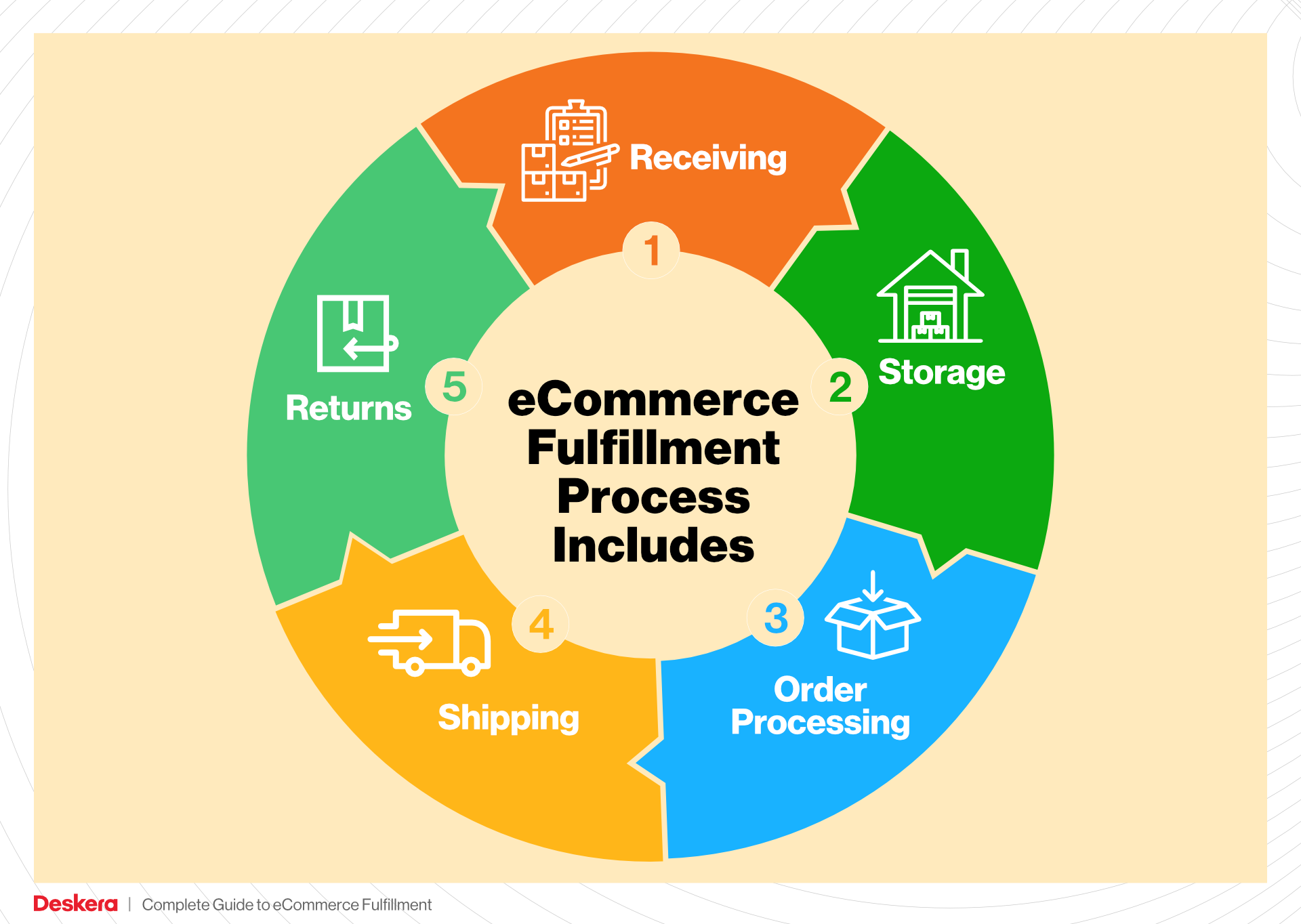
The goal of this guide is to equip you with the knowledge and tools necessary to make smart decisions about your logistics. By optimizing your fulfillment process, you can improve customer satisfaction, reduce operational headaches, and ultimately drive your business growth. Let’s dive into the world of e-commerce fulfillment and unlock the potential for your growing business.
What You’ll Learn In This Guide
- What is E-commerce Fulfillment? An Introduction for Growing Businesses
- The Order Fulfillment Process: From ‘Buy’ Button to Customer’s Door
- Comparing Fulfillment Models: In-House vs. 3PL vs. Dropshipping
- A Deep Dive into Amazon FBA: Pros, Cons, and Who It’s For
- Core Services Offered by Fulfillment Centers
- How to Choose a Fulfillment Partner: A 6-Point Checklist
- Understanding Fulfillment Pricing: A Breakdown of Common Fees
- Frequently Asked Questions (FAQs) about Fulfillment
- Conclusion: Is Outsourcing Fulfillment the Right Move for Your Business?
- Important Disclaimer
The Order Fulfillment Process: From ‘Buy’ Button to Customer’s Door
1. Receiving Inventory
The first step in the order fulfillment process is receiving inventory from suppliers or manufacturers. This is where businesses check incoming shipments for accuracy and quality, ensuring that the right products in the correct quantities have been delivered. This step is crucial because any discrepancies can lead to stockouts or overstock situations, both of which can negatively impact sales and customer satisfaction.
During this stage, businesses should utilize a key term known as SKU (Stock Keeping Unit). Each product should have a unique SKU to facilitate tracking and management. Upon receiving inventory, staff should verify each SKU against the purchase order, inspect for damages, and log the products into the inventory management system. This meticulous process not only maintains inventory accuracy but also sets the foundation for efficient warehouse operations.
2. Warehouse Storage
Once the inventory has been received and verified, the next step is warehouse storage. This involves organizing products in a systematic way within the warehouse to optimize space and make retrieval easy. Effective warehouse storage is vital because it directly influences the speed of order fulfillment and overall operational efficiency.
Businesses should consider utilizing bin locations—a method of organizing products in designated areas within the warehouse. Each SKU should be assigned a specific bin location, allowing for quick and easy access when an order is placed. By implementing a well-structured storage system, businesses can reduce the time spent searching for items, which ultimately leads to faster order processing and improved customer satisfaction.
3. Order Picking
Order picking is the process of retrieving items from the warehouse based on customer orders. This step is critical because the accuracy and speed of picking directly affect the overall fulfillment timeline. Efficient order picking ensures that customers receive the correct items promptly, thereby enhancing their shopping experience.
During this phase, companies often utilize pick lists—documents that outline which items to retrieve for each order. These lists can be generated automatically through inventory management systems. There are various picking methods, including single order picking, batch picking, and zone picking, depending on the volume and type of orders. Implementing the right picking strategy can significantly reduce labor costs and increase the speed of order fulfillment.
4. Order Packing
After the items have been picked, they move to the order packing stage. This process involves securely packaging the products to prevent damage during transit and ensuring that the correct items are included for each order. Packing is crucial because well-packaged orders reduce the likelihood of returns and enhance customer satisfaction.
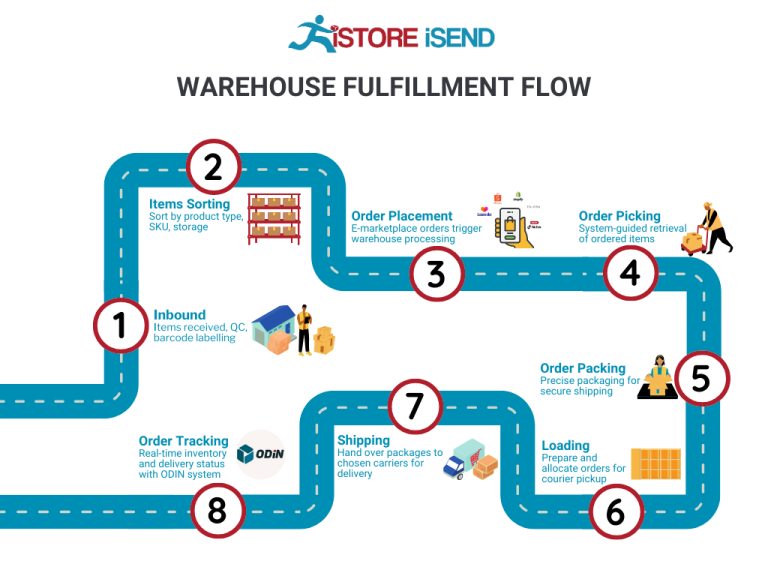
In this step, businesses should focus on using the appropriate packaging materials for their products, which may include boxes, bubble wrap, or padded envelopes. Additionally, including packing slips and return labels can streamline the return process for customers. Proper packing not only protects the products but also reflects the brand’s commitment to quality, encouraging repeat purchases.
5. Shipping & Delivery
The final step in the order fulfillment process is shipping and delivery. This involves selecting a carrier, generating shipping labels, and ensuring that packages are dispatched to customers in a timely manner. This step is particularly important because it directly impacts delivery speed and customer satisfaction.
Businesses should leverage shipping software to automate label generation and track shipments. This software can integrate with various carriers, allowing businesses to compare rates and delivery times to choose the best option for each order. Timely delivery is crucial in today’s competitive e-commerce landscape, as customers increasingly expect fast shipping options. By focusing on efficient shipping and delivery processes, businesses can enhance their reputation and encourage customer loyalty.
In conclusion, understanding each step of the order fulfillment process—from receiving inventory to shipping and delivery—is essential for e-commerce businesses looking to scale their operations. By optimizing these steps and leveraging key terms and technologies, businesses can improve efficiency, reduce costs, and ultimately deliver a superior customer experience.
Comparing Fulfillment Models: In-House vs. 3PL vs. Dropshipping
Comparing Fulfillment Models for TikTok Shop
As e-commerce businesses leverage platforms like TikTok Shop to expand their sales channels, choosing the right fulfillment model becomes crucial for operational efficiency and customer satisfaction. Below, we compare three primary fulfillment models: In-House Fulfillment, Third-Party Logistics (3PL), and Dropshipping.
| Model | Who Handles Inventory | Best For (Business Stage) | Key Advantage | Key Disadvantage |
|---|---|---|---|---|
| In-House Fulfillment | The e-commerce business itself | Established businesses with sufficient resources | Full control over inventory and fulfillment processes | High overhead costs and resource demands |
| Third-Party Logistics (3PL) | A third-party logistics provider | Growing businesses needing scalability | Access to expertise and technology, reduced operational burden | Less control over fulfillment processes |
| Dropshipping | Supplier or manufacturer | Startups or businesses testing new products | Low upfront investment and no inventory risk | Lower profit margins and potential quality control issues |
In-House Fulfillment
In-house fulfillment refers to the process where the e-commerce business manages all aspects of order fulfillment internally. This includes handling inventory storage, order picking and packing, shipping, and customer service. This model is best suited for established businesses that have the resources—both financial and operational—to manage their own fulfillment processes.
The primary advantage of in-house fulfillment is the level of control it offers. Businesses can directly manage their inventory, ensuring that they maintain high-quality standards and can adapt quickly to changes in demand. Moreover, having complete oversight allows for a more personalized customer experience, as businesses can tailor their fulfillment processes to meet specific customer needs.
However, in-house fulfillment also comes with significant challenges. The costs associated with maintaining a warehouse, hiring staff, and investing in logistics technology can be substantial. This model can also lead to operational inefficiencies, especially during peak sales periods when demand surges unexpectedly. Thus, while it offers control, it requires a strong operational foundation to support that control effectively.
Third-Party Logistics (3PL)
Third-party logistics (3PL) involves outsourcing the fulfillment process to a specialized provider. This model has gained popularity among growing businesses that need to scale their operations without the overhead costs associated with in-house fulfillment. In this scenario, the 3PL takes care of inventory storage, order picking, packing, and shipping, allowing the business to focus on other core activities such as marketing and product development.
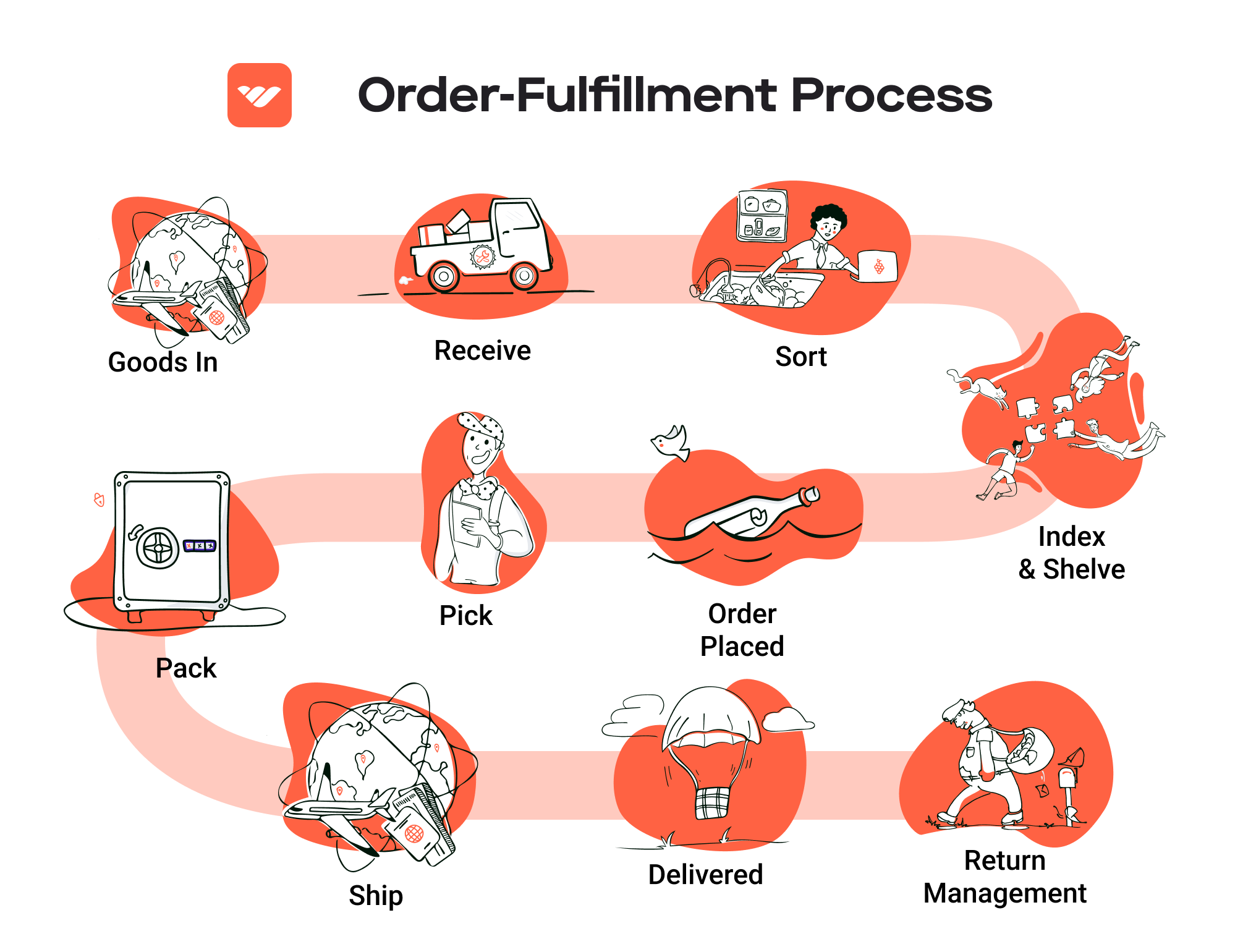
The key advantage of using a 3PL is access to advanced logistics technology and expertise. These providers often have established relationships with carriers, enabling faster shipping options and better rates. This can lead to improved fulfillment metrics, such as reduced shipping lead times and lower late dispatch rates, which enhance the overall customer experience. Additionally, businesses can scale their operations more easily without the burden of managing warehousing and logistics directly.
On the downside, outsourcing fulfillment can mean less control over the process. Businesses may face challenges in aligning their branding and customer service expectations with those of the 3PL provider. There is also a dependency on the provider’s capabilities and reliability, which can pose risks if the 3PL does not meet performance expectations. Therefore, careful selection of a 3PL partner is critical for success.
Dropshipping
Dropshipping is a fulfillment model where the e-commerce business sells products it does not keep in stock. Instead, when a customer places an order, the business purchases the item from a third-party supplier who ships it directly to the customer. This model is particularly appealing to startups or businesses testing new products, as it requires minimal upfront investment and eliminates inventory risk.
The main advantage of dropshipping is its low barrier to entry. Entrepreneurs can start an e-commerce business without the need for significant capital to purchase inventory upfront. This model allows for a wide range of products to be offered without the financial risk associated with unsold stock. Additionally, dropshipping enables businesses to pivot quickly, testing various products and niches without the commitment of holding inventory.
However, dropshipping also comes with notable disadvantages. Profit margins can be lower compared to traditional retail models since the business relies on suppliers who often set the prices. Quality control can also be a concern, as the business has little oversight over the manufacturing and shipping processes. This can lead to inconsistent product quality and longer shipping times, potentially resulting in customer dissatisfaction. As such, while dropshipping offers flexibility, it requires careful management of supplier relationships and customer expectations.
Conclusion
Choosing the right fulfillment model for your TikTok Shop is essential for scaling your e-commerce operations. Each model presents unique advantages and challenges, and the best choice will depend on your business stage, resources, and strategic goals. Whether you opt for in-house fulfillment, partner with a 3PL, or explore dropshipping, aligning your fulfillment strategy with your overall business objectives will be crucial for success in the competitive landscape of e-commerce.
A Deep Dive into Amazon FBA: Pros, Cons, and Who It’s For
Understanding Fulfillment by Amazon (FBA)
Fulfillment by Amazon (FBA) is a service provided by Amazon that allows e-commerce sellers to store their products in Amazon’s fulfillment centers. Once an order is placed, Amazon takes care of storage, packaging, shipping, and customer service on behalf of the seller. This service simplifies the logistics of selling online and allows businesses to leverage Amazon’s extensive logistics network and customer base.
How FBA Works
-
Set Up Your FBA Account: Sellers begin by creating an FBA account through their Amazon seller account. They can then list products as FBA items.
-
Ship Inventory to Amazon: Sellers send their products to Amazon’s fulfillment centers. Amazon provides guidelines on how to prepare and package the items to ensure they are ready for storage and shipping.
-
Storage: Once received, products are stored in Amazon’s warehouses. Amazon manages inventory levels and provides sellers with real-time tracking and reporting.
-
Order Fulfillment: When a customer places an order for an FBA item, Amazon picks, packs, and ships the product directly to the customer.
-
Customer Service and Returns: Amazon also handles customer service inquiries and manages returns, allowing sellers to focus on other aspects of their business.
This streamlined process allows sellers to reach millions of customers and significantly enhances their selling capabilities.
Pros of Using FBA
1. Prime Eligibility
One of the standout advantages of FBA is that products fulfilled through this service are eligible for Amazon Prime, which is a significant draw for many customers. Prime members often prefer to purchase items that qualify for fast, free shipping, which can lead to increased sales for sellers.
2. Customer Trust
Amazon has built a robust reputation for reliability and customer service. By using FBA, sellers can leverage this trust, as customers are more likely to purchase items that are fulfilled by Amazon. This association with Amazon’s brand can lead to higher conversion rates.
3. Multi-Channel Fulfillment
FBA offers the flexibility of multi-channel fulfillment, allowing sellers to use Amazon’s logistics for orders placed on other platforms, such as their own websites or eBay. This feature allows businesses to streamline their logistics and ensure a consistent delivery experience across all sales channels.
4. Scalability
FBA allows businesses to scale operations without the need to invest heavily in warehousing and logistics infrastructure. As order volume increases, sellers can easily send more inventory to Amazon without worrying about managing storage and shipping.
5. Simplified Returns Management
Amazon’s returns process is user-friendly, which can enhance customer satisfaction. FBA handles returns on behalf of sellers, allowing for a seamless experience for customers, which can lead to increased loyalty and repeat purchases.
Cons of Using FBA
1. High Fees
One of the primary drawbacks of FBA is the associated fees. Sellers are charged for storage space in Amazon’s warehouses and for each order fulfilled. These fees can add up, especially for businesses with lower margins or slow-moving inventory.
2. Strict Inventory Rules
FBA has stringent inventory management policies. Sellers must comply with specific guidelines regarding product preparation, labeling, and packaging. Failure to adhere to these requirements can result in additional fees or inventory being returned.
3. Commingling Risks
FBA operates on a commingling basis, meaning that products from multiple sellers can be stored together. This can lead to potential issues with counterfeit products or damaged items being shipped to customers, which can harm a seller’s reputation.
4. Limited Control Over Fulfillment
While FBA simplifies logistics, it also means that sellers have less control over the fulfillment process. This can be a disadvantage for businesses that require specific handling or shipping methods.
5. Dependency on Amazon
Relying on FBA ties a seller’s business to Amazon’s policies and changes. Any updates to Amazon’s fees, rules, or algorithms can significantly impact sellers’ operations and profitability.
Who is FBA Best For?
Fulfillment by Amazon is particularly well-suited for:
-
Small to Medium-Sized Businesses: Businesses looking to scale without the capital investment in logistics infrastructure can benefit significantly from FBA.
-
E-commerce Entrepreneurs: New sellers wanting to tap into Amazon’s massive customer base can leverage FBA to simplify their operations and focus on marketing and product development.
-
Brands with High Demand Products: Sellers with popular products that can benefit from Prime shipping and Amazon’s reputation will find FBA advantageous.
-
Multi-Channel Sellers: Businesses selling on multiple platforms can streamline their logistics by using FBA for all their fulfillment needs.
In conclusion, Fulfillment by Amazon provides a powerful tool for e-commerce businesses looking to scale operations and enhance customer satisfaction. However, it’s essential to weigh the pros and cons carefully to determine if it aligns with your business model and growth strategy. By understanding how FBA works and its implications, sellers can make informed decisions that will benefit their e-commerce ventures.
Core Services Offered by Fulfillment Centers
Inventory Management & Warehousing
Effective inventory management and warehousing are foundational services provided by fulfillment centers. This service encompasses the systematic tracking of stock levels, managing inventory turnover, and ensuring optimal storage solutions.
What It Is:
Fulfillment centers utilize sophisticated inventory management systems that enable e-commerce businesses to monitor their inventory in real-time. This includes capabilities such as automated stock level alerts, barcoding systems, and integration with e-commerce platforms to ensure accurate stock counts.
Benefits:
1. Reduced Overheads: By outsourcing inventory management, businesses can minimize the costs associated with maintaining their own warehousing facilities. Fulfillment centers often operate at scale, allowing them to provide more cost-effective storage solutions.
-
Space Optimization: A fulfillment center can maximize storage space through efficient layout designs and inventory organization, which is often difficult to achieve in smaller, in-house operations.
-
Accuracy and Efficiency: Advanced inventory management systems reduce the risk of human error, ensuring that stock levels are accurately maintained, which helps in preventing stockouts or overstock situations. This accuracy contributes to better customer satisfaction, as products are more likely to be available when needed.
Pick and Pack Services
Pick and pack services are crucial for the efficient processing of orders. This service involves selecting items from the warehouse and preparing them for shipment to customers.
What It Is:
When an order is placed, fulfillment center staff “pick” the items from their designated storage locations and then “pack” them securely for shipping. This process may also include labeling and preparing customs documentation for international shipments.
Benefits:
1. Speed and Scalability: Fulfillment centers employ trained staff and optimized workflows that allow for rapid order processing, which is essential for meeting customer expectations, especially during peak shopping seasons. As order volumes increase, fulfillment centers can scale operations accordingly without requiring additional infrastructure from the business.
-
Quality Control: Many fulfillment centers implement quality checks during the picking and packing process. This ensures that the correct items are shipped in good condition, reducing return rates and enhancing customer trust.
-
Cost Efficiency: By outsourcing this process, businesses can save on labor costs and focus on core activities such as marketing and product development, rather than managing order fulfillment logistics.
Kitting and Assembly
Kitting and assembly services involve the grouping of individual items into ready-to-ship sets or kits. This is particularly useful for businesses that sell products that are often purchased together or require assembly before shipping.
What It Is:
Fulfillment centers can assemble products into kits or bundles according to specific customer orders or promotional strategies. This may involve combining multiple products into one package, adding promotional materials, or even assembling products that require multiple components.
Benefits:
1. Enhanced Customer Experience: Offering pre-assembled kits or bundles can simplify the buying process for customers, as they receive everything they need in one package. This convenience can lead to higher customer satisfaction and repeat purchases.
-
Promotional Opportunities: Kitting allows businesses to easily create promotional bundles, which can help to increase average order value and encourage customers to try new products.
-
Inventory Management: By bundling products, businesses can better manage their inventory levels and turnover rates. Kitting can also help to reduce the complexity of stock management by consolidating multiple SKUs into one.
Returns Management (Reverse Logistics)
Returns management, or reverse logistics, is a vital service offered by fulfillment centers that deals with the processing of returned goods.
What It Is:
This service involves handling product returns from customers, including inspecting returned items, restocking them if they are in sellable condition, and processing refunds or exchanges as necessary.
Benefits:
1. Streamlined Processes: Fulfillment centers can establish efficient return processes that minimize the time and resources spent on handling returns. This can lead to faster resolutions for customers, enhancing their experience and loyalty.
-
Data and Insights: By managing returns through a fulfillment center, businesses can gain valuable insights into return reasons and patterns. This information can inform product development, quality control, and inventory management strategies.
-
Cost Reduction: Handling returns can be labor-intensive and costly. By outsourcing this function to a fulfillment center, businesses can reduce operational costs and focus on core activities, while ensuring that returns are managed effectively.
In summary, partnering with a fulfillment center can significantly enhance an e-commerce business’s operational efficiency and customer service capabilities. By leveraging services such as inventory management, pick and pack, kitting, and returns management, businesses can scale effectively while maintaining a focus on growth and customer satisfaction.
How to Choose a Fulfillment Partner: A 6-Point Checklist
Location & Warehouse Network
Importance: The geographical location of your fulfillment partner’s warehouses can significantly affect shipping times and costs. A well-placed warehouse network can help you reach your customers faster and reduce shipping expenses.
Questions to Ask:
– Where are your warehouses located, and how does that align with my target market?
– Do you have a network of warehouses that can offer multiple shipping options?
– Can you provide fulfillment services in regions where my products are in high demand?
Technology & Integrations
Importance: In today’s digital age, a fulfillment partner’s technology stack is crucial. Effective inventory management systems, order tracking, and seamless integration with your existing e-commerce platforms can enhance efficiency and improve customer satisfaction.
Questions to Ask:
– What technology do you use to manage orders and inventory?
– How do you handle integrations with platforms like Shopify, WooCommerce, or TikTok Shop?
– Can you provide real-time inventory updates and order tracking for my customers?
Specializations (e.g., Cold Storage, Oversized Items)
Importance: If your products require specific handling—such as temperature control for perishables or special storage for oversized items—choosing a partner with the right specialization is essential for maintaining product quality and compliance.
Questions to Ask:
– What types of products do you specialize in handling?
– Do you have the capability for specialized storage, like cold storage or hazardous materials?
– Can you accommodate different packaging requirements for unique items?
Scalability & Capacity
Importance: As your business grows, so will your fulfillment needs. A partner that can easily scale their operations to accommodate increased order volumes will ensure that you can meet demand without operational hiccups.
Questions to Ask:
– How do you handle peak seasons or sudden surges in order volume?
– What is your current capacity, and how quickly can you scale up if needed?
– Can you provide examples of how you have successfully scaled for other clients?
Pricing and Contracts
Importance: Understanding the pricing structure and contract terms is vital for budgeting and financial planning. A clear, transparent pricing model will help you avoid unexpected costs and ensure you get the best value for your investment.
Questions to Ask:
– What is your pricing model (e.g., per order, monthly fees, storage costs)?
– Are there any hidden fees I should be aware of, such as for returns or special handling?
– What are the contract terms, and is there flexibility if my needs change?
Customer Support & Reviews
Importance: Exceptional customer support can differentiate a fulfillment partner from the competition. A responsive and knowledgeable support team can resolve issues quickly and maintain smooth operations. Additionally, positive reviews and testimonials can offer insights into the partner’s reliability and service quality.
Questions to Ask:
– What kind of customer support do you offer (e.g., phone, email, chat)?
– How do you handle order discrepancies or fulfillment errors?
– Can you provide references or case studies from similar businesses in my industry?
Conclusion
Choosing the right fulfillment partner is a critical decision that can impact your e-commerce business’s efficiency and customer satisfaction. By following this checklist and asking the right questions, you can ensure that you select a partner who aligns with your operational needs, growth objectives, and customer expectations. Remember, the right fulfillment partner is not just a service provider; they should be a strategic ally in your business growth journey.
Understanding Fulfillment Pricing: A Breakdown of Common Fees
Initial Setup Fees
When you begin utilizing a fulfillment service, you may encounter initial setup fees. These fees are typically charged when you first establish your account with a fulfillment partner. The fee may cover the costs associated with setting up your inventory in their system, integrating your sales channels (like TikTok Shop), and configuring your account settings.
The calculation of initial setup fees can vary widely depending on the provider. Some fulfillment centers charge a flat fee, while others may have tiered pricing based on the complexity of the integration. It’s essential to clarify what the setup fee includes to avoid unexpected costs later.
Receiving Fees
Receiving fees are incurred when your inventory arrives at the fulfillment center. These charges cover the labor and resources required to unload, inspect, and store your products. Typically, receiving fees are charged per pallet or per item received, depending on the fulfillment center’s pricing structure.
To calculate receiving fees, fulfillment centers may charge based on the number of pallets or boxes delivered. For instance, if a fulfillment center charges $20 per pallet and you send five pallets, your receiving fee would be $100. Always confirm how the receiving process is structured, as some centers may offer discounted rates for larger shipments.
Storage Fees (per pallet/bin)
Storage fees are charged for the space your inventory occupies within the fulfillment center. These fees can be calculated per pallet, per bin, or even per cubic foot, depending on the provider’s pricing model.
Storage fees are typically billed monthly and can vary based on the seasonality of your products. For example, during peak seasons, you might face increased storage fees due to higher demand for space. A common pricing structure might be $15 per pallet per month, which means if you have 10 pallets, your monthly storage fee would amount to $150.
Understanding how storage fees are calculated can help you manage inventory levels effectively and minimize costs. Regularly review your inventory turnover rates to ensure you are not overpaying for storage.
Pick & Pack Fees (per item/order)
Pick and pack fees are charged for the labor involved in retrieving items from storage and preparing them for shipment. These fees can be assessed per item or per order, depending on the fulfillment provider’s policy.
For example, if a fulfillment center charges $2 per item and you have an order consisting of three items, your pick and pack fee would be $6. Alternatively, if they charge a flat fee of $3 per order, regardless of the number of items, you would pay just $3 for the same order.
It’s vital to understand how these fees are structured as they can significantly impact your overall fulfillment costs, especially if you frequently fulfill smaller orders.
Shipping Fees
Shipping fees are among the most significant costs associated with fulfillment and can vary based on multiple factors, including the shipping carrier, package weight, dimensions, and destination. Fulfillment centers typically negotiate rates with carriers and may pass those rates on to you, which can influence your overall shipping expenses.
The calculation of shipping fees usually involves a combination of base rates plus additional charges for weight, dimensions, and delivery speed. For example, a provider might charge a base rate of $5 for standard shipping, with an additional $1 per pound for packages over a certain weight. If you ship a 3-pound package, your shipping fee would be $8.
Tips for Getting an Accurate Quote
-
Request Detailed Quotes: When seeking quotes from fulfillment providers, ask for a detailed breakdown of all potential fees. This should include initial setup, receiving, storage, pick & pack, and shipping fees.
-
Understand Your Needs: Clearly outline your fulfillment needs, including expected order volumes, types of products, and storage requirements. This information can help providers give you a more tailored quote.
-
Consider Seasonal Variations: Inquire about how fees may change during peak seasons or promotional periods. Understanding these fluctuations can help you budget more accurately.
-
Negotiate Rates: Don’t hesitate to negotiate terms with fulfillment providers, especially if you anticipate high volumes. Many fulfillment centers are willing to offer discounts for larger commitments.
-
Compare Multiple Providers: Get quotes from several fulfillment partners to compare pricing structures. This will give you a clearer picture of the market rates and help you make an informed decision.
By understanding these common fees and how they are calculated, you can make more informed decisions about your fulfillment strategy and optimize your logistics costs as you scale your e-commerce operations.
Frequently Asked Questions (FAQs) about Fulfillment
1. What is TikTok Shop Fulfillment?
TikTok Shop Fulfillment refers to the process of managing and delivering orders made through TikTok’s e-commerce platform. This includes inventory storage, order picking, packing, and shipping, which can be handled either through TikTok’s own service, Fulfilled by TikTok (FBT), or through third-party logistics providers (3PLs).
2. How does Fulfilled by TikTok (FBT) work?
Fulfilled by TikTok is a service where TikTok manages the entire fulfillment process for merchants. Sellers send their inventory to TikTok’s fulfillment partners, who then handle the storage, picking, packing, and shipping of orders placed on TikTok Shop. This allows sellers to focus on marketing and content creation while ensuring fast and reliable delivery to customers.
3. What are the benefits of using Fulfilled by TikTok?
Using FBT provides several advantages, including reduced fulfillment costs, faster shipping times, improved order accuracy, and less strain on your own resources. TikTok also offers subsidized storage and shipping, as well as customer service support for shipping inquiries.
4. What is a third-party logistics provider (3PL)?
A third-party logistics provider (3PL) is a company that offers outsourced logistics services, including warehousing, fulfillment, and shipping. By partnering with a 3PL, businesses can delegate their order fulfillment processes, allowing them to scale operations without investing in their own logistics infrastructure.
5. How can I fulfill TikTok Shop orders without using FBT?
If FBT is not available in your market, you can still fulfill TikTok Shop orders by utilizing a 3PL or by self-fulfilling orders. With a 3PL, you would connect your TikTok Shop to the logistics provider for order management. Alternatively, self-fulfillment involves managing storage, packing, and shipping on your own.
6. How much do fulfillment services cost?
The cost of fulfillment services varies based on several factors, including the size and weight of your products, order volume, and the specific services you require. Generally, you can expect to pay for storage fees, picking and packing fees, and shipping costs. It’s advisable to request quotes from multiple fulfillment providers to find the best fit for your business.
7. What’s the difference between a warehouse and a fulfillment center?
A warehouse is primarily used for storing inventory, while a fulfillment center is designed for processing and shipping orders. Fulfillment centers offer services such as order picking, packing, and shipping, and are often equipped with technology to facilitate faster order processing and tracking.
8. How do I manage inventory for TikTok Shop fulfillment?
To effectively manage inventory for TikTok Shop, you can use inventory management software that integrates with your sales channels. This allows you to track stock levels in real-time, manage reordering, and allocate inventory between TikTok Shop and other sales platforms efficiently.
9. Can I use Fulfilled by TikTok if I’m not a TikTok user?
Yes, you can use Fulfilled by TikTok even if you do not have a personal TikTok account. However, you will need to set up a TikTok Shop account to access the FBT services and manage your products and orders through the platform.
10. How can I improve my fulfillment efficiency on TikTok Shop?
To enhance fulfillment efficiency, consider using automated inventory management systems, optimizing your warehouse layout, and leveraging the Fulfilled by TikTok service if available. Additionally, offering express shipping options can improve customer satisfaction and increase repeat purchases. Regularly review your fulfillment processes to identify areas for improvement and ensure timely order delivery.
Conclusion: Is Outsourcing Fulfillment the Right Move for Your Business?
Assessing the Benefits of Outsourcing Fulfillment
As e-commerce businesses increasingly turn to platforms like TikTok Shop to drive sales, the question of whether to outsource fulfillment becomes crucial. Leveraging a fulfillment service can offer significant advantages, particularly in terms of saving time, achieving scalability, and accessing specialized expertise.
By outsourcing fulfillment, businesses can free up valuable resources and time that can be redirected toward marketing, product development, and enhancing customer experience. This is particularly important in a fast-paced environment like TikTok, where trends can change overnight, and the ability to respond quickly can be the difference between capitalizing on a viral moment and missing the opportunity entirely.
Moreover, a reliable fulfillment partner can provide the scalability needed to manage fluctuating order volumes, especially during peak seasons or as your business grows. With services like Fulfilled by TikTok, businesses can easily adapt to increases in demand without the burden of managing inventory, staffing, and logistics in-house.
However, the success of outsourcing fulfillment hinges on choosing the right partner. The ideal fulfillment service should align with your business needs, enhance your operational efficiency, and support your growth objectives. It’s essential to conduct thorough research and possibly audit your current shipping processes to determine if a fulfillment partner could streamline your operations and improve your bottom line.
Call to Action
Take the first step towards optimizing your fulfillment strategy: conduct an audit of your current shipping processes. Identify bottlenecks, areas for improvement, and growth potential. By assessing your needs, you can make an informed decision about whether outsourcing fulfillment is the right move for your business. Don’t leave your success to chance; explore the possibilities of fulfillment partnerships today.
Important Disclaimer
⚠️ Important Disclaimer
The information in this guide is for educational purposes. Fulfillment services, pricing, and platform features change frequently. Always conduct your own due diligence and consult with providers directly before making business decisions.
